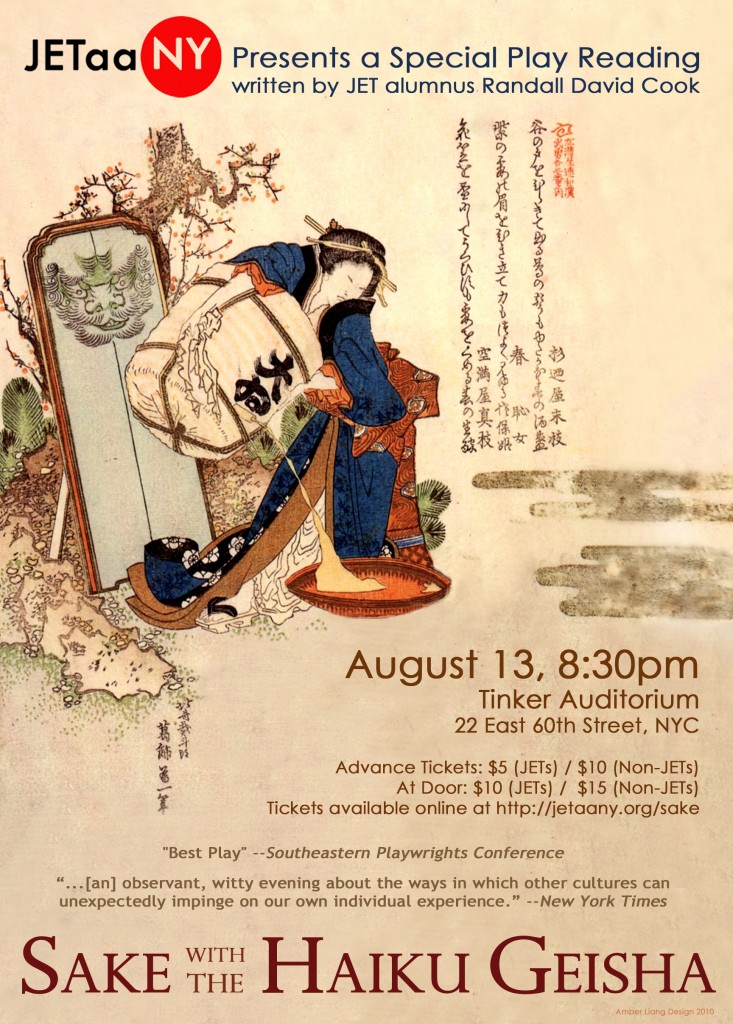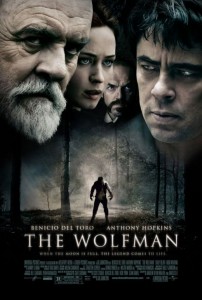Event: “Sake With the Haiku Geisha” reading, August 13 (NYC)
JET ALUMNI ASSOCIATION OF NEW YORK (JETAA NY)
with support from the Consulate General of Japan in New York
Presents
A Special Play Reading of critically acclaimed Off Broadway Play
SAKE WITH THE HAIKU GEISHA
The JET Alumni Association of New York is pleased to present a limited one-night reading of the critically acclaimed play “Sake with the Haiku Geisha,” written by JET alumnus and playwright, Randall David Cook (Fukui-ken, 1991-93).
Date: Friday, August 13
Start time: 8:30 p.m.
Location: Tinker Auditorium (between Park & Madison Aves.) 22 E 60th St, New York, NY 10065, (212) 355-6100
Cost:
- $5 in advance ($10 at the door) for JET alumni
- $10 in advance ($15 at the door) for Friends of JET
CLICK HERE TO PURCHASE TICKETS ON-LINE VIA PAYPAL
“Sake with the Haiku Geisha” premiered Off-Broadway in 2006 and was based on the collective experiences of three JETs who were placed in Fukui-ken from 1991-1993: an American from South Carolina, a Canadian from Nova Scotia and an English woman from Devon. The structure of the play is inspired by the classic Noh play: an opening ceremony, five acts (each of which uses a different speaker and a spirit or ghost), and a closing ceremony. The show starts on at a farewell party for the visiting JETS, and first three acts are told from the perspective of the visiting JETs, and then the tables turn, and the final two acts are told from the perspective of two Japanese: the supervisor of the Canadian JET, and the geisha’s story, which closes out the play.
The first act, “Sushi and Scones” was a finalist in five major festivals in the USA and England, won the “Best Play” award at the Southeastern Playwrights Conference and was taped and broadcast by as a BBC radio play in late 2005. See a full review of the play in the New York Times.
This event is being organized in cooperation with the Consulate General of Japan in New York.
Tom Baker interviews “Airbender” cast
Tom Baker (Chiba-ken, 1989-91) is a staff writer for The Daily Yomiuri. As another example of JET ROI, he is one of at least four former JETS to have been on the newspaper’s staff in recent years. He usually writes for DYWeekend, the arts and leisure section. You can follow Tom’s blog at tokyotombaker.wordpress.com.
Recently he interviewed two members of the cast of “The Last Airbender” movie during their promotional visit to Tokyo, asking them for their views on the “racebending” controversy surrounding their film. He also covered an insect show now running at a Tokyo museum, reviewed the manga “Otomen,” and weighed in on a couple of other movies now playing in Japan. Here are some excerpts:
“Last Airbender”
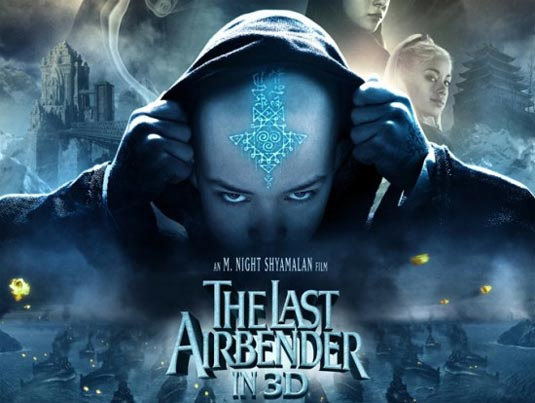 In the United States, some fans of the anime-style cartoon on which the movie is based have protested against the casting of Jackson Rathbone and Nicola Peltz, who are white, in roles the fans saw as Asian.
In the United States, some fans of the anime-style cartoon on which the movie is based have protested against the casting of Jackson Rathbone and Nicola Peltz, who are white, in roles the fans saw as Asian.
Asked to comment on that, Rathbone said: “I originally was a finalist for Prince Zuko [a Fire Nation role that went to Slumdog Millionaire star Dev Patel]. Almost a year later, I was brought back in for the character of Sokka…I think what they were really looking for was the qualities that people represent, not so much focusing on race…All these characters [in the cartoon] have so many different features, you can’t really say that they are one race…It’s a shame that people really focus on the race thing and they don’t understand that it’s a story for everyone.”
“And there are over 120 different types of people in the film,” Peltz added.
“In terms of a big-budget film, it’s the most ethnically diverse cast there’s ever been,” Rathbone agreed.
Read the rest of the interview here.
“Insects festival”
Open your window on a hot summer day and you may hear a sound that caught the ear of haiku poet Matsuo Basho in the 17th century: the voices of cicadas, seeping into the rocks. Of course, Japan today is a lot more urbanized than it was in Basho’s time, and cicadas are more likely to sing against a background of asphalt and cement. Yet year after year, the buzzing bugs never fail to show up, even in the heart of Tokyo.
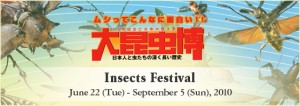 Visitors to Insects Festival, an exhibition now running at the Edo-Tokyo Museum in Ryogoku, Tokyo, are reminded of such persistence right away with a display of six-legged critters that live in three different Tokyo zones: mountains, fields and downtown areas.
Visitors to Insects Festival, an exhibition now running at the Edo-Tokyo Museum in Ryogoku, Tokyo, are reminded of such persistence right away with a display of six-legged critters that live in three different Tokyo zones: mountains, fields and downtown areas.
While city-dwellers often resent sharing space with the likes of cockroaches and ants, the emphasis of this show is on seasonal outdoor insects whose diverse shapes, bright colors and occasional songs actually enhance city life…
Read the rest of the article here, or visit the exhibition’s site here.
“Otomen”
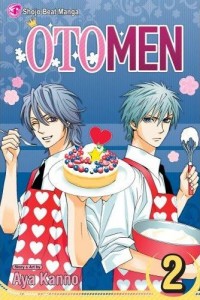 Anyone writing a graduate thesis on the presentation of gender in Japanese pop culture will find abundant material in the manga series Otomen. Readers looking for laughs will also find what they seek in Otomen, but rather less abundantly.
Anyone writing a graduate thesis on the presentation of gender in Japanese pop culture will find abundant material in the manga series Otomen. Readers looking for laughs will also find what they seek in Otomen, but rather less abundantly.
The main characters are a trio of high school students, with the focus on Asuka (a boy who has a name more common for girls), who is in love with Ryo (a girl who has a name more common for boys). Their would-be romance is complicated by the constant presence of their friend Juta, who tries to play cupid, but is more often a third wheel.
Asuka is the captain of the school kendo team, and is admired by everyone as a “real man.” But he is secretly an “otomen,” a boy who is into girly things, such as cute stuffed animals and delicate pastries. He is at least as skilled at cooking and sewing as he is at sports, but he keeps that side of himself hidden. Ryo is Asuka’s mirror image in that she has been raised by her socially inept father to follow in his footsteps as a martial arts champion, but she strives to put up a feminine front at school. Juta has a secret, too, as he is actually a best-selling manga artist who is using the couple as a model for his stories…
Also playing…
You can read Tom’s review of “Inception” here, and his review of “Zombieland” here.
Tom Baker reviews “Crazy Heart” and “Brothers”
Tom Baker (Chiba-ken, 1989-91) is a staff writer for The Daily Yomiuri. He usually writes for DYWeekend, the paper’s arts and leisure section. You can follow Tom’s blog at tokyotombaker.wordpress.com.
Recently he reviewed movies, “Crazy Heart” and “Brothers.” He found poetry in both of them. Here are some excerpts:
“Crazy Heart”
Country music singer-songwriter Bad Blake (Jeff Bridges) smokes like a chimney, drinks like a fish, sweats like a pig, and urinates into a plastic jug while driving from town to town. As I watched him perform under hot lights at a variety of small and unglamorous venues in the movie Crazy Heart, I could almost smell him. He didn’t smell very nice.
…
On the bright side, Bad’s personal problems are grist for the mill. One of his most popular songs looks back on a dissipated life with the refrain, “Funny how fallin’ feels like flyin’/for a little while.”
Anyone who doubts that country music is the primary home of modern American poetry should meditate on that line. “Funny how fallin’ feels like flyin'” is alliterative and catchy, but also trenchant. And Bad has flown and fallen quite a way…
Read the rest of the review here.
“Brothers”
In William Shakespeare’s play about his life, King Richard II is forced to surrender his crown to his usurper cousin Henry IV. In doing so, Richard compares himself and Henry to two buckets in a well: “The emptier ever dancing in the air,/The other down, unseen and full of water:/That bucket down and full of tears am I,/Drinking my griefs while you mount up on high.”
The title characters in Brothers, although they dwell in an American suburb rather than an English castle, are not unlike the tragic royal cousins.
Sam (Tobey Maguire) is an upstanding husband, father and U.S. marine who is about to be separated from his family for a tour of duty in Afghanistan. On the eve of Sam’s departure, his surly brother Tommy (Jake Gyllenhaal), a ne’er-do-well with a drinking problem, rejoins the extended family after a stint in prison…
Read the rest of the review here.
An International List of Writing Organizations and Opportunities
Laura Popp (Mie-ken, 2009-Present) is a current JET who writes fantasy and science fiction for children and young adults, and is an occasional playwright/film maker. Her short work includes a short story titled “In theShadow Realm” and a documentary she made in Malawi. To read about her amazing adventures all over Japan, go to her blog at laurajanepopp.blogspot.com.
Here is a practical list of organizations, market guides, and networking opportunities for jump starting your writing career. My apologies that it is heavy on the America and Speculative Fiction side, but that is who I am and what I write, so that is what I know best. But hopefully everyone can find something useful from this list:
How to Present Yourself to a Publisher or Agent at a writers conference
**************
Laura Popp (Mie-ken, 2009-Present) is a current JET who writes fantasy and science fiction for children and young adults, and is an occasional playwright/film maker. Her short work includes a short story titled “In theShadow Realm” and a documentary she made in Malawi. To read about her amazing adventures all over Japan, go to her blog at laurajanepopp.blogspot.com. (And check out the Authors/Books section of the JetWit Library for a list of more writers in the JET-o-sphere.)
Tired of submitting queries to agents and editors and simply getting form rejection letters or worse, NO RESPONSE? Wondering if they`re even bothering to read your stuff? Frustrated by wanting to submit to publishing houses that only receive submissions from agents and “referred” writers? Consider meeting publishers and agents at a conference!
Recently I returned from a writers` conference in my home in Oklahoma and came back with some great success stories to tell. Even better than the wonderful presentations on writing, polishing and marketing were the opportunities for networking and industry contacts. One literary agent asked me for the first fifty pages of my middle grade novel Dargon, another agent requested a proposal for my young adult novel Treasure Traitor, and a publisher from Simon and Shuster asked to see the full manuscripts of BOTH. A travel publisher also requested a proposal for a non-fiction travel-essay book on Japan, and best of all, a Christian magazine publisher accepted one of my stories on the spot! Of course, most of these are just birds in the bush, if you will, but they are certainly a good start.
So how did you do it? you may be wondering. Well, let me tell you…
Do your homework
Many conferences post information about editors and agents who will be attending in advance. Research them and pick the ones that look like they may be interested in your completed fiction projects or non-fiction ideas. Note that most agents and publishers will ONLY consider finished fiction works and proposals for non-fiction articles and books.
Try to make an appointment
If you have the option to make an appointment, Read More
JQ Magazine’s May/June 2010 “JET Author Issue” Out Now!
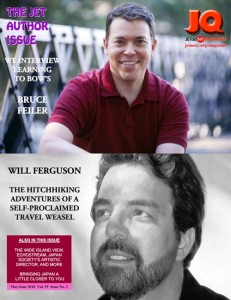 It’s a veritable JET literary review in the new issue of JQ, featuring an interview with bestselling Learning to Bow author Bruce Feiler and three-time Stephen Leacock Medal winner Will Ferguson! Click here to view.
It’s a veritable JET literary review in the new issue of JQ, featuring an interview with bestselling Learning to Bow author Bruce Feiler and three-time Stephen Leacock Medal winner Will Ferguson! Click here to view.
Additional contents below. Thanks to JQ editor Justin Tedaldi (Kobe-shi CIR, 2001-02) for another solid issue. Contact Justin if you’d like to pitch or write a story for the next issue.
CONTENTS
- Page 3….From the Editor, New Country Reps
- Page 4….Nippon News Blotter / Wynne Memorial
- Page 5….JETAANY Election Recap
- Page 5….Gorgeous Entertainment by Anthony Waldman
- Page 6….Int’l Center of New York by Pamela Kavalam
- Page 6….Yoko Shioya of Japan Society by Lyle Sylvander
- Page 7….JETlog Feauturing Gail Cetnar Meadows
- Page 8….Bruce Feiler: The JQ Interview by Justin Tedaldi
- Page 9….JETAANY Society Page Photos
- Page 10…Nihonjin in NY: Nobuya Nagahama by Stacy Smith
- Page 11….Echostream Rocks the Anime Circuit by Earth Bennett
- Page 13.…Robataya Restaurant Review by Nancy Ikehara
- Page 13….The Niigata Sake Book by Yukari Sakamoto
- Page 14.…Will Ferguson: Canadian Cousin by Joshua Graubart
- Page 15….The Funny Page
Tom Baker interviews 2 movie directors, pans one manga
Tom Baker (Chiba-ken, 1989-91) is a staff writer for The Daily Yomiuri. He usually writes for DYWeekend, the paper’s arts and leisure section. You can follow Tom’s blog at tokyotombaker.wordpress.com.
He recently interviewed Shane Acker, director of the animated film “9” and Richard Kelly, who most recently directed “The Box,” a thriller starring Cameron Diaz. He also reviewed the manga “Hot Gimmick.” Here are some excerpts:
Shane Acker
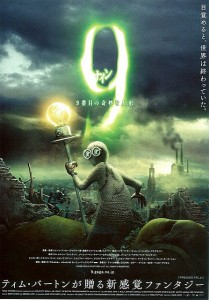 [The characters in the movie are all animated dolls with numbers instead of names.] A different personality aspect is dominant in each one. Rigid orthodoxy is represented by leader 1 (voiced by Christopher Plummer), creativity by inventor 2 (Martin Landau), bravery by warrior 7 (Jennifer Connelly) and so on. Elijah Wood does the voice of 9, the truth-seeker of the group, and John C. Reilly voices his timid friend, 5…
[The characters in the movie are all animated dolls with numbers instead of names.] A different personality aspect is dominant in each one. Rigid orthodoxy is represented by leader 1 (voiced by Christopher Plummer), creativity by inventor 2 (Martin Landau), bravery by warrior 7 (Jennifer Connelly) and so on. Elijah Wood does the voice of 9, the truth-seeker of the group, and John C. Reilly voices his timid friend, 5…
The most amusing character is 8 (Fred Tatasciore), who embodies sheer physicality. In one scene, he achieves a moment of strange bliss by stroking his head with a large magnet, an activity that Acker called “degaussing himself.”
“In film school, especially in the days of video, if you had a videotape and you wanted to just wipe it clean, there’s a degaussing machine, which is basically like a supermagnet, and you would wave the videotape over the degausser and it would just take off all the footage that’s on there,” Acker explained. “So that’s the kind of idea, he’s sort of wiping his memory banks. You realize why he’s so dumb.”
Richard Kelly
Imagine that a mysterious stranger has just handed you a wooden box with a red button on top. He explains, rather convincingly, that if you push the button two things will happen: Someone whom you don’t know will die, and you will receive a payment of 1 million dollars…
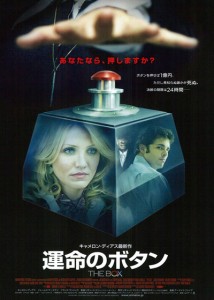 In writer-director Richard Kelly’s movie The Box, based on a short story by Richard Matheson, the stranger’s name is Arlington Steward (Frank Langella), and he is conducting a high-stakes social experiment by visiting the homes of middle-class American couples and offering them the choice of pushing the button or not.
In writer-director Richard Kelly’s movie The Box, based on a short story by Richard Matheson, the stranger’s name is Arlington Steward (Frank Langella), and he is conducting a high-stakes social experiment by visiting the homes of middle-class American couples and offering them the choice of pushing the button or not.
“Tonally this movie crosses a lot of genres,” Kelly, who previously wrote and directed Donnie Darko (2001) and Southland Tales (2006), told The Daily Yomiuri in a recent phone interview. “It’s a science fiction film, it’s a domestic melodrama, it’s a suspense film, there’s elements of horror in it, and there’s also some black comedy inherent…The conceit of pushing this button on this contraption and someone you don’t know dying is very mischievous. Anyone who would build this contraption and make this offer is smirking when they do it. And Matheson was smirking, I’m sure, when he wrote this short story.”
…[The story is set in the 1970s because] the mysterious stranger is a character type whose day has passed, according to Kelly. “When I set out to write this screenplay, I initially was trying to figure out how to make it work present-day, but when you introduce modern technology and the Internet, social networking sites, Google maps, satellite maps, reality TV, just our media-saturated world that we live in…there is no such thing as a real stranger anymore. Everyone can be found on the Internet. You can find anyone’s house, you can go onto a satellite map with a 360-degree view.”
“Hot Gimmick”
 [In this manga, a high school girl’s seriously unhealthy relationships with her would-be boyfriends is presented as perfectly normal.]
[In this manga, a high school girl’s seriously unhealthy relationships with her would-be boyfriends is presented as perfectly normal.]
For example, the day after one of her suitors is unable to reach her by phone (for reasons that are no one’s fault), he slaps her across the face so hard that bystanders rush to offer first aid. But Hatsumi chases after him to make the following speech, which he receives in stony silence: “I’m sorry. For being so clueless. For…never being able to get your calls…I’m so sorry. I’m really sorry. For not understanding how you feel about me. I’m sorry.”
Later, when one of the boys proposes to her, she thinks, “Maybe if we got married, he’d finally be nice to me.”
She seems unaware of some basic principles of healthy human interaction, such as this simple standard: If a friend arranges for you to be gang-raped, that person is not really your friend.
JET Author: Bruce Feiler’s latest on living with cancer
You may have seen his face on The Colbert Report or his byline in The New York Times, but the bestseller Bruce Feiler got his start after college in JET. His first publication, though, was spurred by his experience in Japan as a JET teacher in the inaka: Learning to Bow: An American Teacher in a Japanese School in 1991.
Many successful titles and even a PBS miniseries later, Feiler is back with another personal account on his experience after he was diagnosed with cancer. The young father of two daughters set off to write to them with the advice of six guiding men in his life. The group of his college roommates and childhood friends, penned “The Council of Dads,” provide the wisdom that he seeks for himself and his family. The rest of his personal battle with chemo therapy and lingering fears for his family unfold in his latest book: The Council of Dads – My Daughters, My Illness, and the Men Who Could Be Me.
As an early reviewer from United’s Hemispheres Inflight Magazine noted: “The book’s power comes in part from Feiler’s willingness to delve into emotions—including feelings of tenderness not only for our children and spouses but between male friends—that aren’t often spoken of with such candor.” And it’s not surprising, because for much of his career as a writer, he has lead readers through both the clamor of a JET classroom and the Biblical journey through the steps of Abraham.
Check out his extensive speaking event schedule for May and June. He’ll be hitting bookstores and cafes in California, Georgia, Illinois, Maryland, Massachusetts, Missouri, New York, North Carolina, Ohio, and Pennsylvania in two months!
Follow him on Twitter or Facebook, and here’s a trailer for his book.
Translators: Part-time work (Japanese to English)
An Upstate company is in search of someone who could help out part time translating documents from Japanese to English. The company is partially owned by a Japanese company. The company suggests a student or someone who lives in the area as an ideal candidate.
If you are interested or knows of someone that is capable, contact me for details.
Daniel Stone
danone19(AT)gmail.com
Tom Baker reviews “Moon,” “Shutter Island” and “The Wolfman”
Tom Baker (Chiba-ken, 1989-91) is a staff writer for The Daily Yomiuri. He usually writes for DYWeekend, the paper’s arts and leisure section. You can follow Tom’s blog at tokyotombaker.wordpress.com.
His two latest articles are movie reviews, one of “The Wolfman,” and one that discusses “Moon” and “Shutter Island” together. Here are some excerpts:
In most werewolf movies nowadays, it is standard to show a person’s nose and jaw elongating into a snaggletoothed lupine muzzle when they transform from human to wolf. [Makeup artist Rick] Baker has done that before, but in this film he pays homage to Lon Chaney Jr.’s furry but still humanoid look in the 1941 film The Wolf Man, on which the new film is based. Then and now, the title monster has modest fangs, a woolly forehead, a beard that goes up to his eyes and a nose that darkens at the tip.
Our first glimpse of Baker’s version of this classic face is literally over in a flash, as we see it illuminated by a pistol shot during a nocturnal battle. (In case you missed it the first time, the scene repeats a moment later, with a larger gun.) Later scenes reveal the monster’s face at greater length.
MOON and SHUTTER ISLAND
Teddy Daniels and Sam Bell are men who love their wives. They are also the respective protagonists of two new movies, Shutter Island and Moon, that take us far enough inside the characters’ heads to see each man passionately embracing his wife in a dream.
But when Teddy awakes, he finds himself trapped on his movie’s titular island, unhappily remembering that his wife has been dead for years. And when Sam awakes, he finds himself trapped on his movie’s titular heavenly body, unhappily remembering that his wife is on Earth, and he has not seen her for many months.
Teddy (Leonardo DiCaprio) is a U.S. marshall investigating the disappearance of an inmate from a prison hospital for the criminally insane on Shutter Island, Mass., in the 1950s. Sam (Sam Rockwell) is the solitary human staffer of a mining facility on the dark side of the moon, possibly in the 2050s.
The settings are very different, but both are ominous, isolated places in which intense psychological drama will unfold. In both movies, the protagonists have high-stakes confrontations with themselves, and with the powers that be.
Read the rest of the review here. The review is deliberately spoiler-free, but you can read Tom’s further comments about the endings of “Moon” here and “Shutter Island” here.
Another Side of Travel
*************
Laura is a current JET who writes fantasy and science fiction for children and young adults, and is an occasional playwright/film maker.
Namaskaram! Greetings from India! Ever consider volunteering abroad? With all our JET paid vacation time, there`s lots of opportunities. It looks great on your resume, and it’s a sure way to give you inspiration for your writing! Why stick to the touristy spots you can read about? You can get a feel for “the real thing” by helping out in the rural villages and slums, and see a part of the world you might never see otherwise.
I definitely just got a feel for the “real India” after spending ten days in Andhra Pradesh building houses and teaching the children of Dalits (untouchables) with five other English teachers through Longitude International. What an amazing experience! The moment we entered Chuvuru village we were greeted by drums and dancing. The people welcomed us into their homes and there seemed no end to the smiles, laughter, and chai tea!
We spent our mornings helping build new cement houses that would stand the tempest of the fall monsoons, and our evenings teaching and playing with the children. In the beginning they were shy and called me “madam,” but within a few hours they completely opened up and called me “sister.” “Sister, one more song, one more photo, one more dance!” Boy, did they love to dance! We taught them the hokey pokey, the Macarena, head-shoulders-knees-and-toes, everything we could think of, and in return they showed us their “Bollywood moves.” They also loved my fife and recorder. Whenever I brought them out, they instantly began shouting requests.
During a game of “let`s travel,” one of the kids asked me, “Your village?” I didn`t know how to respond. Temple, Texas, where I was born? Owasso or Tulsa Oklahoma where I was raised and went to school? Nabari, Japan, where I live now? Malawi, Africa, where I left a huge part of my heart with the AIDS orphans? Or right there in Chuvuru where I felt so at home?
It was a bit of an identity crisis. I asked myself if I really “belong” anywhere. For weeks I`ve been nervous about my upcoming visit back to the States and wondering if it has “changed,” or more importantly, if I`ve changed. Will I feel “at home” in the place my friends and family consider to be my “home?”
After puzzling over it I came to a rather relieving, though somewhat clichéd conclusion. The world is my village. Perhaps that sounds cheesy, but I really think so. Not that I would be welcome let alone feel comfortable anywhere in the world, but I think wherever I do go where there are welcoming hearts and warm smiles, that place will be my home, my village for as long as I am there. And the villagers of India really are so welcoming, so loving that you feel like one of them from the very beginning. There is no insider/outsider. Only friend and family.
Of course, the trip wasn`t all fuzzy feelings. It was very difficult to see how some of the people suffered. Thirty years ago in a nearby village, the government gave the Dalits land to farm, but are now taking it back. This forces the villagers to migrate long distances through dangerous roads or hire themselves out as domestic servants where they are physically and sexually abused. Disease is still a major problem, claiming many lives.
So a lot of people have asked me, why did you bother going to India? There`s not much you can do to help anyway; why not just send money? Sending money is great, but if I`m traveling anyway, I might as well make a difference as I do and experience the “real world.” I can already tell you, those kids and that place are already showing up in my fiction!
We were the first volunteer group to visit Chuvuru, but this is only the beginning of their brighter future. Hopefully many more teams will come to help build and teach, continuing the cause of awareness, human rights, and global friendship. Who knows, maybe you`re next? If you`re interested in learning more about longitude and their work, you can visit their website at http://www.golongitude.org/.
For more details, pictures, and videos about Laura`s adventures in Asia, visit her weekly blog at laurajanepopp.blogspot.com.
Roland Kelts to speak at “Anime Boston” – Sat., April 3
Hey JETAA New England! Join Roland Kelts (Osaka-shi, 1998-99), author of Japanamerica, at Anime Boston this coming weekend for a Japanamerica talk and book-signing session Saturday, April 3, @ 1:30 p.m. in the Hynes Convention Center in downtown Boston.
Bankruptcy Man vs. Mortgantua, Part 7 – by Steven Horowitz
Bankruptcy Man and Bankruptcy Bill are cartoons created by Steven Horowitz (Aichi-ken, 1992-94) and Gideon Kendall. For more cartoons, original bankruptcy haiku and even a bankruptcy country song, go to bankruptcybill.us.
Do you work in bankruptcy or restructuring? Now you can join the JET Alumni Restructuring & Bankruptcy Group on LinkedIn.
Additionally, if anyone would like to take a stab at translating the cartoon into Japanese for JetWit’s Japanese fans out there, feel free to post in the comments section of this post. Some cultural explanation might be helpful as well, given that Japanese bankruptcy laws are very different than the U.S.
JQ Magazine’s March/April 2010 “Go East Issue” Online Now!
Event: JET alum authors Roland Kelts and Karl Taro Greenfeld to speak in Philadelphia – March 26
After a quick jaunt back to Tokyo, Roland Kelts (Osaka-shi, 1998-99), author of Japanamerica, is back in the U.S. and on the road this week for a short stint for the Association of Asian Studies’ (AAS) Annual Meeting in Philadelphia, where he will appear on Friday, March 26 for a discussion panel called “The Japan Knowledge Industry Outside the Academy“ with fellow author and JET Alum Karl Taro Greenfeld (Kanagawa-ken, 1988-89) (Speed Tribes: Days and Nights With Japan’s Next Generation), author William M. Tsutsui (Godzilla on my Mind), journalist Misako Hida (The Wall Street Journal Japan), and Professor Laura Miller (Bad Girls of Japan).
The discussion takes place this Friday, March 26, from 10:45 a.m. to 12:45 p.m. at the Philadelphia Marriott Downtown Hotel. More info can be found under “# 69” here: http://www.aasianst.org/annual-meeting/2010/Friday.pdf
Philly-area JET alums are encouraged to swing by and say hello.

